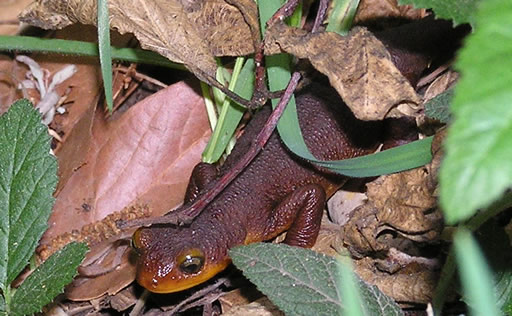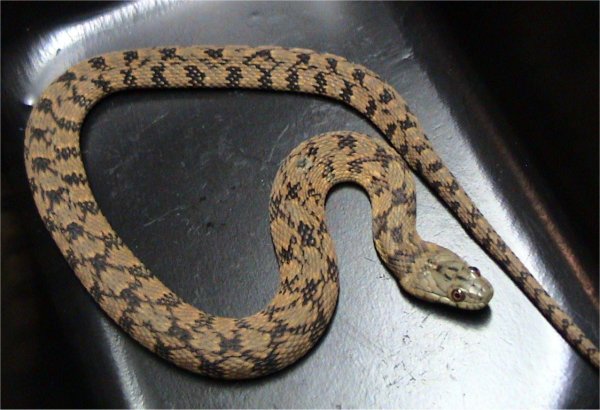Please see Part I of this article for further information.Last time we took a look at the amazing diversity of tiny invertebrates that inhabit leaf litter, and their importance as food for small terrarium animals such as poison frogs, dwarf leaf chameleons, and young frogs, lizards, mantids and scorpions.
Collecting Leaf Litter Invertebrates
As mentioned in Part I of this article, the springtails, ants, mites, millipedes and other creatures inhabiting a single acre of fallen leaves can add up to an astonishing 3 tons in weight! So how do we harvest all of this free food?
A technique borrowed from professional entomologists (insect scientists) works quite well. Simply place a handful of leaf litter into a funnel, suspend the funnel over a jar and position a 100 watt bulb about 6 inches above the leaves. The heat will drive the resident invertebrates down the funnel and into the jar. A damp paper towel placed at the bottom of the collecting jar will assure that the more delicate animals survive.
Using Wild-Caught Invertebrates
Remove potentially dangerous animals such as biting ants and centipedes, and dispense the rest to your poison frogs, baby anoles and other such creatures. Their reactions to this novel food will convince you of its worth – most terrarium animals become noticeably excited and feed ravenously each time they are presented with novel prey species.
Use Petri dishes if you prefer to keep your pets’ meals confined to one area. Springtails, sowbugs and others may colonize the terrarium substrate if allowed to disperse, which is also useful in some cases. You can also place small piles of leaves directly into the terrarium (after checking for dangerous species) – its great fun to watch frogs and other creatures search through them for tasty snacks.
Zoo Experiences
Others far more inventive than I came up with this technique, but I have long championed it in my articles and books…usually without much luck! Even among my zoo co-workers, my pleas fell on deaf (if amused!) ears.
So, upon touring several zoos in Japan recently I was thrilled to learn that several keepers, after reading about the topic in a book that I wrote some years back (Newts and Salamanders, which for some reason is popular in Japan), tried it out. Their results were so positive that the technique is now a regular part of the husbandry regime in several collections!
Trapping Tiny, Flying Insects
The Zoo Med Bug Napper, a very effective insect trap that I rely upon throughout the warmer months, will attract tiny gnats, moths, beetles and flies along with larger insects. These too make fine foods for your smaller pets.
Further Reading…Meadow Plankton
“Meadow plankton” is a term given to the myriads of insects and other invertebrates that can be gathered by sweeping a net through tall grass in fields and in overgrown areas along roads, farm edges, parks, etc. These creatures can also be fed to smaller reptiles, amphibians and invertebrates. Please look for my future article on this topic.
Until then, a partial species list of insects that might be encountered in a typical temperate zone meadow, along with other information, is available on the website of the Invertebrate Conservation Trust.
 That Reptile Blog – Reptile, Amphibian and Exotic Pet Care and Information
That Reptile Blog – Reptile, Amphibian and Exotic Pet Care and Information

 Over 200 compounds, some of which are medically significant, have been isolated from newt and salamander skins. Western North America’s rough-skinned newt (Taricha granulosa) possesses what may very well be the salamander world’s most powerful secretions…a single adult packs enough to kill 25,000 mice. More than one person (usually male, drunk and involved in some sort of “initiation” or dare), has suffered fatal consequences after swallowing a rough-skinned newt.
Over 200 compounds, some of which are medically significant, have been isolated from newt and salamander skins. Western North America’s rough-skinned newt (Taricha granulosa) possesses what may very well be the salamander world’s most powerful secretions…a single adult packs enough to kill 25,000 mice. More than one person (usually male, drunk and involved in some sort of “initiation” or dare), has suffered fatal consequences after swallowing a rough-skinned newt. Although the California newt’s (Taricha torosa) toxins pale in comparison to those of its rough-skinned cousin, they are not to be trifled with. I kept a California newt with an American eel for 17 years. The eel, a voracious predator that would as soon latch onto my hand as anything else, never once molested its seemingly defenseless tank-mate.
Although the California newt’s (Taricha torosa) toxins pale in comparison to those of its rough-skinned cousin, they are not to be trifled with. I kept a California newt with an American eel for 17 years. The eel, a voracious predator that would as soon latch onto my hand as anything else, never once molested its seemingly defenseless tank-mate. Background color varies through shades of pale gray to dark brown, with reddish to black cross-bands. Juveniles are brightly marked, while the colors of older animals usually darken. Stoutly built, the northern watersnake may reach 4 ½ feet in length, but averages 3 feet.This species interbreeds with its subspecies, the midland water snake, which may confuse identification at range overlaps.
Background color varies through shades of pale gray to dark brown, with reddish to black cross-bands. Juveniles are brightly marked, while the colors of older animals usually darken. Stoutly built, the northern watersnake may reach 4 ½ feet in length, but averages 3 feet.This species interbreeds with its subspecies, the midland water snake, which may confuse identification at range overlaps. This snake can build up large populations in suitable habitat but, in my experience, does not adjust well to human presence (it is sometimes killed in the mistaken belief that it is venomous and reduces game fish numbers).
This snake can build up large populations in suitable habitat but, in my experience, does not adjust well to human presence (it is sometimes killed in the mistaken belief that it is venomous and reduces game fish numbers). Raccoons, although native, have also become problematical in recent years. Now well adjusted to people, they thrive everywhere…during my years as a nuisance wildlife trapper, I caught scores throughout NYC, including in some of Manhattan’s most densely-populated neighborhoods.
Raccoons, although native, have also become problematical in recent years. Now well adjusted to people, they thrive everywhere…during my years as a nuisance wildlife trapper, I caught scores throughout NYC, including in some of Manhattan’s most densely-populated neighborhoods.